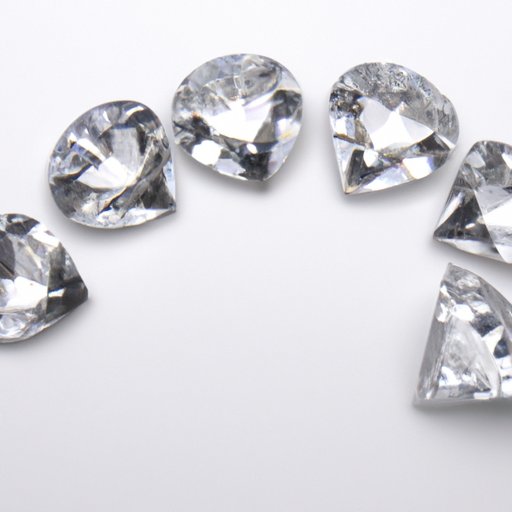Introduction
Natural diamonds are one of the world’s most beloved gems. They have been treasured for centuries for their beauty and rarity, and they remain an important symbol of wealth and status today. But what exactly is a natural diamond? How do they form and what are their physical properties? This article will explore all these questions and more, providing an in-depth look at natural diamonds from their formation to their ethical considerations.
Exploring the Science Behind Natural Diamonds
Natural diamonds are created over billions of years under extreme heat and pressure deep within the Earth’s mantle. The process of diamond formation begins with carbon, which is subjected to intense temperatures of 900–1300°C and extreme pressures of 45–60 kilobars. Under these conditions, the carbon atoms are rearranged into the familiar crystalline structure of a diamond.
Natural diamonds have a variety of physical characteristics that make them unique from other gemstones. They have the highest thermal conductivity of any known material, meaning they can quickly and efficiently transfer heat. They also have the highest hardness rating of any mineral, making them incredibly durable and resistant to scratches and wear. Natural diamonds can also be distinguished by their optical properties; they have a high refractive index, giving them their signature sparkle and brilliance.

A Guide to Buying Natural Diamonds
When purchasing natural diamonds, it is important to consider several factors, including the 4Cs (cut, color, clarity, and carat), which are used to identify and grade natural diamonds. Cut refers to the shape and proportions of the diamond, color to its hue and saturation, clarity to the presence or absence of flaws or blemishes, and carat to its weight. Each of these factors contributes to the overall value of a diamond and should be taken into account when shopping for natural diamonds.
In addition to the 4Cs, it is also important to consider the origin of the diamond. Many natural diamonds sold today come from conflict zones, where the proceeds of their sale are used to finance armed groups. Therefore, it is important to purchase diamonds from reputable sources who adhere to the Kimberley Process, an international system designed to prevent the trade of conflict diamonds.
The History of Natural Diamonds
Natural diamonds have a long and storied history. They were first discovered in India in the fourth century BCE and were prized for their beauty and rarity. Throughout the centuries, they were used as symbols of power and prestige, often given as gifts to royalty and nobility. Natural diamonds were also widely used in jewelry and other decorative items.
Today, natural diamonds are still highly sought after and remain an important symbol of wealth and status. They are also used in a variety of industries, from electronics to aerospace, due to their unique physical properties. Natural diamonds are also popular for engagement rings and other fine jewelry pieces.

How to Identify and Grade Natural Diamonds
Identifying and grading natural diamonds requires specialized training and equipment. Professional gemologists use a variety of characteristics to distinguish natural diamonds from other gemstones, such as their crystal structure, luster, and fluorescence. Additionally, diamonds can be graded according to the 4Cs, as well as by other measures such as clarity and symmetry.
Professional gemologists use a variety of tools to grade natural diamonds, including microscopes, magnifying loupe, and special lighting systems. These tools allow them to accurately identify and grade natural diamonds according to the industry standards.

Ethical Considerations When Buying Natural Diamonds
When buying natural diamonds, it is important to consider the ethical implications of your purchase. Conflict diamonds, which are diamonds mined in areas controlled by rebel forces, are a major concern in the diamond industry. To ensure that your purchase does not contribute to the financing of armed conflicts, it is important to purchase diamonds from sources that adhere to the Kimberley Process.
It is also important to consider the source of the diamond. Responsible sourcing is becoming increasingly important in the diamond industry, as consumers become more aware of the environmental and social impacts of diamond mining. By purchasing diamonds from socially and environmentally responsible sources, you can ensure that your purchase is helping to create a better future for all involved.
Conclusion
Natural diamonds are some of the most beautiful and coveted gemstones in the world. This article has provided an overview of natural diamonds, including their formation, physical properties, uses throughout history, buying guide, methods for identification and grading, and ethical considerations. By understanding the science and history behind natural diamonds, as well as the ethical implications of their purchase, you can make informed decisions when shopping for this precious gem.
For more information on natural diamonds, please visit the Gemological Institute of America’s website or consult a professional gemologist.


